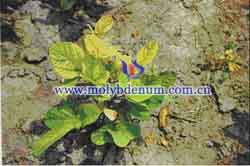Soybean Molybdenum Deficiency

The main symptoms of soybean molybdenum deficiency are stunting and failure of leaves to develop a healthy dark green colour. The leaves of affected plants show a pale green or yellowish green colour between the veins and along the edges. In advanced stages, the leaf tissue at the margins of the leaves dies. The older leaves are the more severely affected. In cauliflowers, the yellowing of the tissue on the outer leaves is followed by the death of the edges of the small heart leaves. When these develop, the absence of leaf tissue on their edges results in the formation of narrow, distorted leaves to which the name ‘whiptail’ has been applied. Affected leaves are usually slightly thickened and the leaf edges tend to curl upwards, especially in tomatoes.
It has been mentioned that legumes such as peas and beans need molybdenum either for utilisation of nitrates (as do non-legumes), or for nitrogen fixation by root nodule bacteria. Where molybdenum is deficient, and adequate nitrogen is available from fertilisers applied to the soil, symptoms of molybdenum deficiency are similar to those seen in non-legumes, namely, interveinal and marginal leaf chlorosis followed by death of the tissue on the leaf margins. These symptoms are seen in a condition found in french beans in the Gosford district, to which the name ‘scald’ has been applied. In lucerne, clover and other pasture legumes, the main symptoms are associated with an inability to fix atmospheric nitrogen. This stunting and yellowing is identical with nitrogen deficiency and resembles legumes having no nodules and grown in poor soils.
If you have got any interest in molybdenum metals, please feel free to contact us by email: sales@chinatungsten.com, sales@xiamentungsten.com or by telephone:86 592 512 9696/86 592 512 9595.
Related Links: Molybdenum News & Prices
